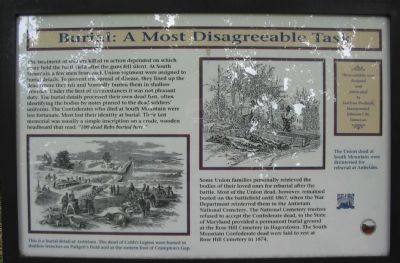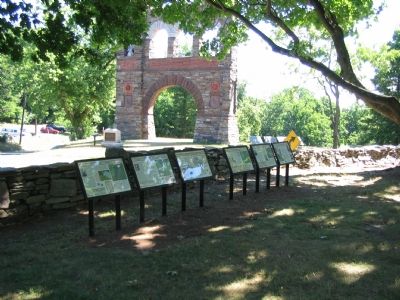Near Burkittsville in Frederick County, Maryland — The American Northeast (Mid-Atlantic)
Burial: A Most Disagreeable Task
Some union families personally retrieved the bodies of their loved ones for reburial after the battle. Most of the Union dead, however, remained buried on the battlefield until 1867, when the War Department reinterred them in the Antietam National Cemetery. The National Cemetery trustees refused to accept the Confederate dead, so the State of Maryland provided a permanent burial ground at the Rose Hill Cemetery in Hagerstown. The South Mountain Confederate dead were laid to rest at Rose Hill Cemetery in 1874.
These exhibits were designed and fabricated by SunSyne Products, Incorporated, Johnson City, Tennessee.
Erected by Blue & Gray Educational Society / State of Maryland Department of Natural Resources.
Topics. This historical marker is listed in this topic list: War, US Civil. A significant historical year for this entry is 1867.
Location. 39° 24.312′ N, 77° 38.364′ W. Marker is near Burkittsville, Maryland, in Frederick County. Marker is at the intersection of Gapland Raod and Arnoldstown Road, on the left when traveling west on Gapland Raod. Across the road from the War Correspondent’s Memorial Arch, in Gathland State Park. Touch for map. Marker is in this post office area: Burkittsville MD 21718, United States of America. Touch for directions.
Other nearby markers. At least 8 other markers are within walking distance of this marker. The Stage is Set (here, next to this marker); Bartlett Leads the Way (here, next to this marker); Medal of Honor Recipients (here, next to this marker); Troup Light Artillery (here, next to this marker); Padgett’s Field: Confederate Last Stand (here, next to this marker); Journalists Who Gave Their Lives (within shouting distance of this marker); GATH: The Man and His Mountain (within shouting distance of this marker); Gath's Empty Tomb (within shouting distance of this marker). Touch for a list and map of all markers in Burkittsville.
More about this marker. The marker features two drawing depicting burial details
at work. The left side drawing is captioned, “This is a burial detail at Antietam. The dead of Cobb’s Legion were buried in shallow trenches on Padgett’s Field at the eastern foot of Crampton’s Gap.” The right side drawing states, “The Union dead at South Mountain were disinterred for reburial at Antietam.”
Also see . . .
1. Death in the Civil War. General discussion of how death was considered in the Civil War, with a section on the disposition of the bodies after battles. (Submitted on August 22, 2007, by Craig Swain of Leesburg, Virginia.)
2. Civil War “Dog Tags”. While early in the war, a simple piece of paper was used to identify the dead, later the soldiers themselves adopted the unofficial practice of wearing a metal disk with identification information. This foreshadowed the modern use of identification tags or “Dog Tags.” (Submitted on August 22, 2007, by Craig Swain of Leesburg, Virginia.)
Credits. This page was last revised on June 16, 2016. It was originally submitted on August 22, 2007, by Craig Swain of Leesburg, Virginia. This page has been viewed 1,904 times since then and 14 times this year. Photos: 1, 2. submitted on August 22, 2007, by Craig Swain of Leesburg, Virginia. • J. J. Prats was the editor who published this page.

